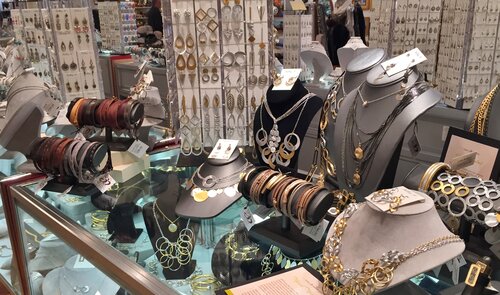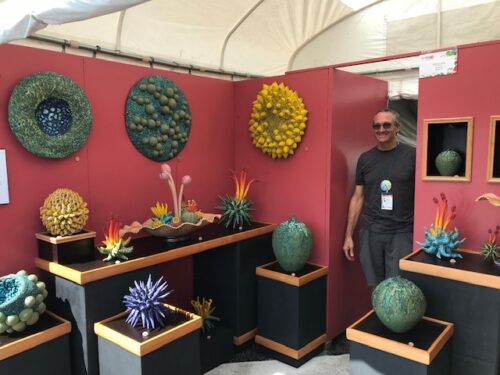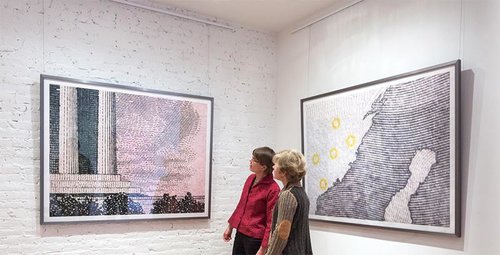by Carolyn Edlund
Give your customers a visual clue as to the value and desirability of your work by using thoughtful presentation.

Overcrowded displays cause visual chaos that turns off shoppers
On a tourist trip through a historic Pennsylvania town, I walked into a local art and craft gallery, where I encountered one of the most egregious merchandising fails I’d ever seen. The retailer carried many well-known handmade lines as well as fine art and paintings, but their staff clearly didn’t understand how to display them properly. Instead of a pleasant shopping experience, I faced chaos and confusion.
Two-dimensional art competed with display racks against the walls, sometimes overlapping. The jewelry counter (shown above) was jammed with so much merchandise it was impossible to focus on anything. Rather than celebrating the unique nature of handmade art and craft, the impression was more like a rummage sale at a discount store. Handmade work looked more like commodity items. The result was a perceived value lower than the actual asking price of the merchandise.
Avoid these mistakes in your show booth, studio or other venue where your work is shown for sale. When walking shows, I’ve witnessed exhibitors who used every square inch of space available in their booth. A better approach is thoughtful merchandising that allows the customer to clearly view and appreciate each piece.
Displays that work
Contrast the cluttered retail space with my visit to ArtFest Fort Myers where I visited the booth of Florida-based ceramic artist William Kidd. He put smart strategies into practice in his display (below) that looked more like a gallery than an outdoor show booth at a street fair.
Each piece of his ocean-inspired sculptural work was placed on individual pedestals like precious objects, conveying their uniqueness and value. Black stones clustered at the base of each piece echoed the organic look of his artwork, while giving a neutral background that allowed the art to stand out.

Ceramic artist William Kidd’s booth display at ArtFest Fort Myers
Note the different heights of the displays in his booth; these led the eye around the space. Each piece was also touchable, inviting sensory engagement. Larger pedestals held carefully spaced groupings of work. Small niches set into the booth wall contained individual works, framing them with trim look matched the pedestals. Stepping into his booth was like entering a boutique-like gallery filled with visual delights.
Smart merchandising increases the perceived value of the art for sale. The use of negative space gives breathing room, allowing the eye to rest on each piece individually and avoiding clutter in the visual field. Art galleries, jewelry stores and high-end retailers know how to do this well. They allow plenty of room for each item to shine, making it appear special and worthy of consideration. Strategic lighting enhances the display, drawing customers in to see more. Customers see the work as more collectible and valuable.
Additional Strategies
Use carefully selected groupings and appropriate spacing between works of art to lead potential collectors through your display. Large or eye-catching pieces may be hung as showpieces near the entrance to attract visitors and invite them to view more. This can be done in a gallery or even a temporary show booth.

Photo credit: Blueprint 22
Follow through by using smaller groupings or works that tell a story as the visitor explores. Signage and additional collateral placed in a display helps the viewer understand the art and experience it more deeply.
Interested in more display strategies to give the best presentation of your artwork? View my interview on YouTube with experts Christine Regan Davy and Pete Dunn from Gallery System Art Displays for thought-provoking ideas.
